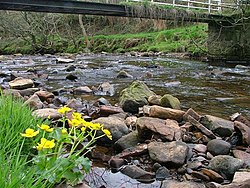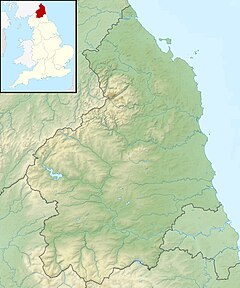Haltwhistle Burn
| Haltwhistle Burn | |
|---|---|
 Haltwhistle Burn | |
| Location | |
| Country | United Kingdom |
| County | Northumberland |
| Physical characteristics | |
| Mouth | |
• coordinates | 54°58′00″N 2°26′37″W / 54.9666°N 2.4437°W |
The Haltwhistle Burn is a river which lies to the east of the Northumbrian town of
Geology and associated industries
The rocks underlying this part of
Water power
The bed of the burn descends into the valley at a gentle angle of approximately 1 degree but the fall is sufficient to have run a corn mill and three woollen manufactories during the 18th and 19th centuries. The earliest of these processes to be mechanised was fulling, with the first records on the site dating to 1612. Later, with advances in technology, the carding and spinning of wool was also carried out in watermills. The advent of steam-driven mills led to the abandonment of woollen processing along the burn. Two mills were demolished in the 1930s and the remaining fulling mill is now a dwelling.[3][4]
Roman fort

The remains of Haltwhistle Burn Roman Fort are situated on the eastern bank of Haltwhistle Burn, just north of the point where it is crossed by the
Just to the north of the fort are three separate Roman marching camps.
Citizen science
The Haltwhistle Burn has been used as an important pilot site for an innovative citizen science research project led by Newcastle University.[5] The project enabled the local community to monitor the weather and water environment using simple and low-cost methods, including rainfall, river levels and flood events. This has provided locals and scientists, who are concerned about preserving the health of the Haltwhsitle Burn, with increased knowledge in order to manage flood risk, water quality and river morphology issues.[6][7] These citizen science observations are being used to fill the data gaps in order to understand and manage location-specific issues. Commencing in 2013, the project was one of the first in the UK to explore and implement citizen science in this way.[8]
References
- ISBN 0-85272-541-8.
- ISBN 1-873551-11-8.
- ^ History of the Manor and Church of Haltwhistle, C.E. Adamson, 1861, published by George Nicholson, Southshields.
- ^ History, Topography, & Directory of Northumberland (Hexham Division) ed. T.F. Bulmer 1886, pub. T. Bulmer & Co. Manchester
- ^ Newcastle University. "Haltwhistle Burn". Retrieved 27 April 2017.
- S2CID 130235656.
- ^ "Community Involvement in UK Catchment Management" (PDF). Foundation for Water Research.
- .

